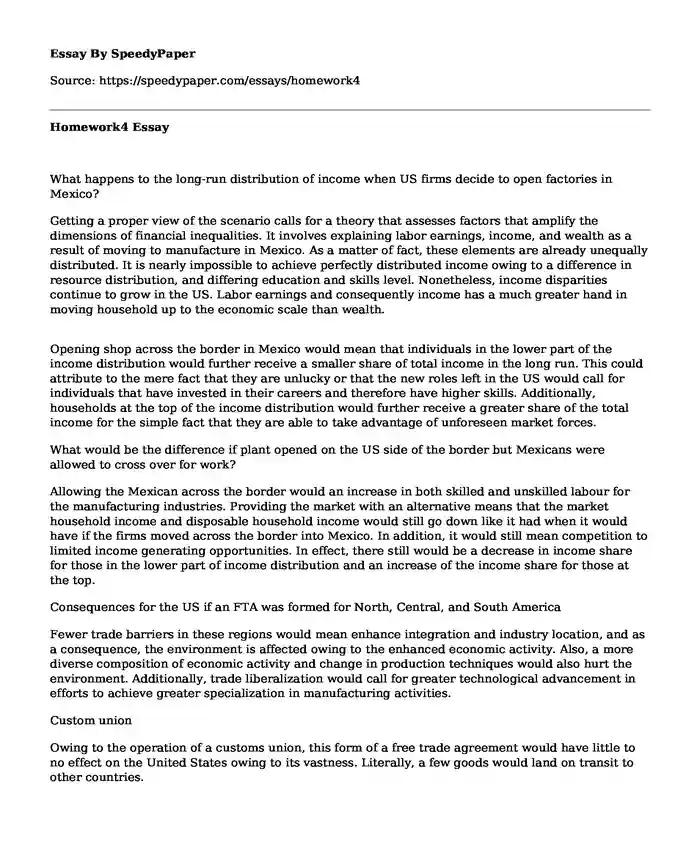
| Type of paper: | Problem solving |
| Categories: | Psychology Economics Analysis Personality Society |
| Pages: | 3 |
| Wordcount: | 556 words |
What happens to the long-run distribution of income when US firms decide to open factories in Mexico?
Getting a proper view of the scenario calls for a theory that assesses factors that amplify the dimensions of financial inequalities. It involves explaining labor earnings, income, and wealth as a result of moving to manufacture in Mexico. As a matter of fact, these elements are already unequally distributed. It is nearly impossible to achieve perfectly distributed income owing to a difference in resource distribution, and differing education and skills level. Nonetheless, income disparities continue to grow in the US. Labor earnings and consequently income has a much greater hand in moving household up to the economic scale than wealth.
Opening shop across the border in Mexico would mean that individuals in the lower part of the income distribution would further receive a smaller share of total income in the long run. This could attribute to the mere fact that they are unlucky or that the new roles left in the US would call for individuals that have invested in their careers and therefore have higher skills. Additionally, households at the top of the income distribution would further receive a greater share of the total income for the simple fact that they are able to take advantage of unforeseen market forces.
What would be the difference if plant opened on the US side of the border but Mexicans were allowed to cross over for work?
Allowing the Mexican across the border would an increase in both skilled and unskilled labour for the manufacturing industries. Providing the market with an alternative means that the market household income and disposable household income would still go down like it had when it would have if the firms moved across the border into Mexico. In addition, it would still mean competition to limited income generating opportunities. In effect, there still would be a decrease in income share for those in the lower part of income distribution and an increase of the income share for those at the top.
Consequences for the US if an FTA was formed for North, Central, and South America
Fewer trade barriers in these regions would mean enhance integration and industry location, and as a consequence, the environment is affected owing to the enhanced economic activity. Also, a more diverse composition of economic activity and change in production techniques would also hurt the environment. Additionally, trade liberalization would call for greater technological advancement in efforts to achieve greater specialization in manufacturing activities.
Custom union
Owing to the operation of a customs union, this form of a free trade agreement would have little to no effect on the United States owing to its vastness. Literally, a few goods would land on transit to other countries.
Common Market
First consequence would be the cost of legislation in order to adjust to a common rule across the regions. A single market would mean more regulations to the already existing federal and state ones. However, in benefits, the common market would bring with it increased trade. It could also divert trade from better and more efficient non-regional markets.
Monetary union
Inflation differentials will be persistent in the US alongside other member countries. Nonetheless, a common currency could contribute greater economic integration however, US strong economic linkages with the rest of the world would suffer a setback. The
Cite this page
Homework4. (2022, Dec 05). Retrieved from https://speedypaper.com/essays/homework4
Request Removal
If you are the original author of this essay and no longer wish to have it published on the SpeedyPaper website, please click below to request its removal:
- Gender Equality Essay Sample
- Aspiration Statement. Essay Example.
- Literary Essay Sample on Elena Ferrante's "Troubling Love"
- Free essay: Food Poisoning Claims and Event Risk Solving
- Type 2 Diabetes refers to a chronic medical condition characterized by an individual's body inability to maintain blood glucose at a normal level due to the body cells develop resistance to insulin hormone effect or inability of the pancreas to produce enough insulin for optimal functioning (Chrvala, Sherr & Lipman, 2016). An individual diagnosed with type 2 diabetic condition requires to effectively undertake several self-care management interventions such as leading a healthy lifestyle (active physical activity, appropriate dietary plan, and body weight) and sticking to their medication or insulin therapy plan (Chrvala, Sherr & Lipman, 2016). It is essential for an individual living with type 2 diabetic condition to effectively undertake self-care management interventions to facilitate the improvement of the quality of life by ensuring favorable care outcomes (Chrvala, Sherr & Lipman, 2016). This research paper evaluates applications of various learning theories perspectives ineffective provision of patient education to young adults on type 2 diabetes and medication adherence towards enhancing their self-care management capability.
- Free Essay: How Men and Women Have Differences in Income
- Strategic Planning at Duke Hospital: SWOT Analysis for Quality Services - Paper Example
Popular categories




